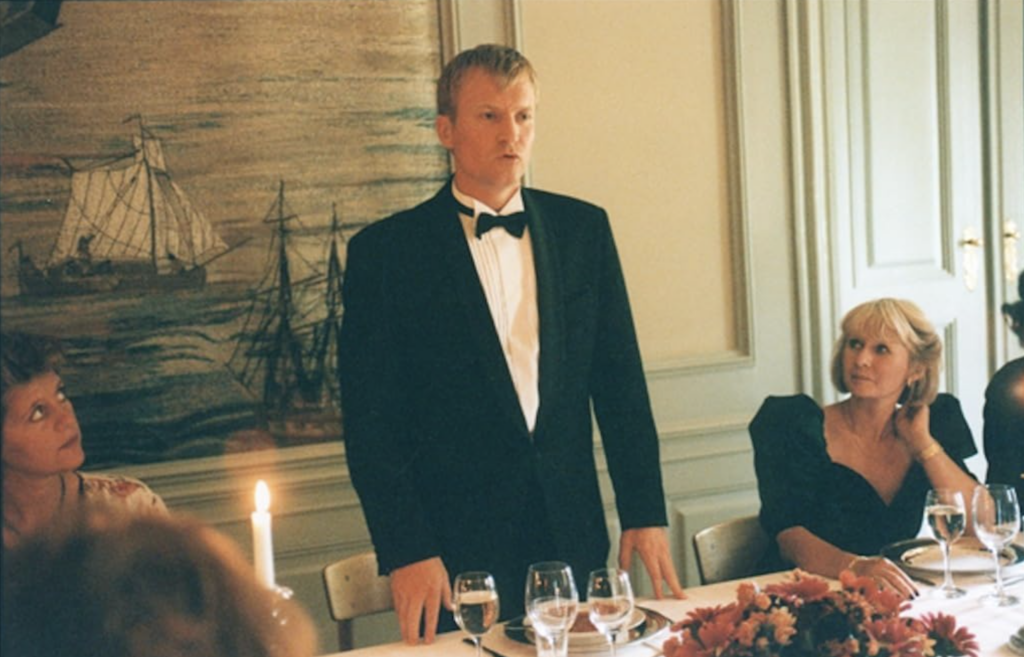The Celebration (Festen is its original Danish title) encapsulates the dizzying innovation and creativity the 1990s afforded the independent filmmaker. Thomas Vinterberg and his crew shot the feature on the emerging medium of digital video, using a tiny handheld camcorder. This is also the first Dogme 95 movie, which meant it adhered to a set of rules. They are:1
- Shooting must be done on location. Props and sets must not be brought in.
- The sound must never be produced apart from the images or vice versa. (Music must not be used unless it occurs where the scene is being shot.)
- The camera must be hand-held.
- The film must be in colour. Special lighting is not acceptable.
- Optical work and filters are forbidden.
- The film must not contain superficial action. (Murders, weapons, etc. must not occur.)
- Temporal and geographical alienation are forbidden. (That is to say that the film takes place here and now.)
- Genre movies are not acceptable.
- The film format must be Academy 35 mm.
- The director must not be credited.
Are these rules stifling? Obstructing? If The Celebration is proof, the answer is a resounding no. No doubt because Vinterberg intended to make a Dogme film, he chose to use a mini DV camera. That choice changed the look of cinema, offering a fuzzier image but allowing more creative handheld shots. The sound is also raw, with voices echoing off the walls in the spacious hotel where the movie takes place. And perhaps in defiance of the “chastity” Dogme 95 promotes, there is a hallucination in The Celebration that is masterfully conceived, lit by the flame of a temperamental cigarette lighter.
The real reason The Celebration works (and the reason it received a 15-minute ovation and the Jury Prize at Cannes) is the acting and the story. I have written before how only actors matter—they are the bearers of pathos in a film. Hire a workmanlike director and a middling cinematographer, but if your cast shines, you have yourself a good movie. Not so the other way around. (Of course, it helps to have all the pieces—Anthony Dod Mantle, who won an Oscar for Slumdog Millionaire, shot The Celebration in glorious 720i mini DV.)

The story is also riveting. As extended family gather to celebrate a patriarch’s 60th birthday, Christian decides this is the time to reveal how he and his twin sister were sexually abused by their father the patriarch—this hidden abuse drove his twin to her recent suicide. There is confusion, doubt, denial, recriminations, and revelations. The drama is so intense, the viewer eventually forgets about the TV-like picture and focuses on the players. I remember seeing this in the Laemmle in West L.A., curiously scrutinizing the video-film transfer to see if this was indeed the future of cinema. It wasn’t long before my study ceased and I settled in to enjoy the movie.
Digital video is now the norm for indie moviemakers. It’s opened up a world of possibilities without the punishing costs of film stock and lab work. But I fear modern filmmakers often lean too hard into papering over their lacks instead of leaning into them. Do a web search for “how to make my digital video look like film” and you’ll find a wealth of technical articles on gamma and color profiles. That’s not art; it’s engineering. Adjust your black levels, sure, but not at the expense of immediacy of emotion.

As well, Dogme 95 has been criticized as unnecessary artifice, but I appreciate the sometimes-need to think about filmcraft we take for granted. Why are you making a genre film? Why did you introduce a gun into the scene and is there another way you can advance the action? In The Celebration, Dogme 95 freed Vinterberg from conventional camera placements and opened him up to some innovative movements. To be sure, Vinterberg flouted the rules a few times—Helene discovers her sister’s suicide note by following arrows drawn on the ceiling by the filmmakers and Vinterberg confessed to masking a window at one point. Rules are made to be broken, but they’re also made to make one think on why they exist in the first place. We’re in an era of both overabundant dross and boundless creativity in cinema. Vinterberg and The Celebration were at the beginning of that.

